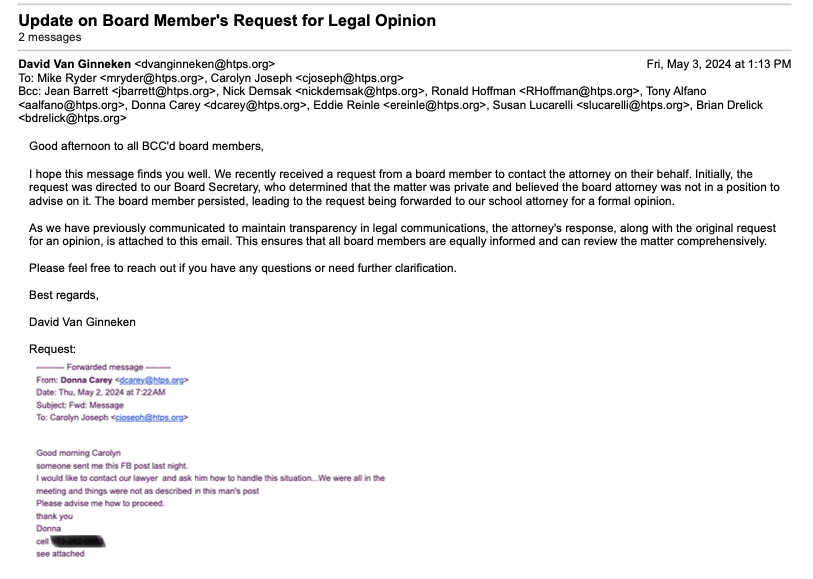Transparency in governance is not just a best practice; it is an obligation to the community we serve. However, Board President Donna Carey has repeatedly demonstrated that her version of transparency applies only when it serves her personal or political interests. This post highlights the correct way to handle transparency in board communications-and exposes how Carey has failed to uphold these standards.
A Model for Transparency: Sharing Legal Communications with the Entire Board
A legal request from a board member showcased the correct way to handle transparency. Initially, the request was directed to the Board Secretary, who determined that the matter was private and did not require legal consultation. However, the board member persisted, and the request was ultimately escalated to the school attorney.

The correct approach to transparency was followed:
- All board members were notified of the request and the attorney’s response.
- The legal opinion was shared in full with the board, ensuring that no individual held privileged information.
- A formal explanation was provided, allowing the board to review the matter collectively.
This approach ensures that no single board member, including the president, holds unilateral access to legal guidance that should be available to all elected officials. It establishes a clear precedent: real transparency means equal access for all board members, not selective disclosure based on political convenience.
Donna Carey’s Approach: Selective Transparency and Power Hoarding
In stark contrast, Donna Carey has repeatedly engaged in legal consultations without informing the full board, despite her constant claims of valuing transparency. Carey has sought legal opinions in secret, failed to notify board members until after decisions were made, and actively rejected proposals for increased transparency-particularly when it meant holding herself accountable.
Her pattern of behavior demonstrates a blatant double standard:
- She modifies policies to consolidate her own power while rejecting transparency provisions.
- She selectively shares legal consultations when it benefits her but withholds them when they challenge her authority.
- She claims others are the source of “drama” while actively fueling division through secretive governance.
This is not transparency. This is an abuse of power.
Key Takeaways for Maintaining Transparency
- All legal requests should be documented and shared with the full board immediately.
- Legal opinions obtained by the board must be distributed to all members without delay.
- No individual board member, including the president, should use legal counsel for personal or political gain.
- Any refusal to provide transparency should be recognized as a governance failure.
Conclusion: Donna Carey’s Selective Transparency Hurts the Community
Transparency is not optional-it is fundamental to ethical leadership. The community deserves a board that functions openly and honestly, ensuring that all decisions are made with full awareness of their legal and financial implications.
Yet, under Donna Carey’s leadership, transparency has been reduced to a political weapon-used when convenient and ignored when inconvenient. If she truly valued transparency, she would lead by example instead of engaging in selective governance.
The precedent has been set for how transparency should work. The only question now is: will Donna Carey and her allies finally follow it, or will they continue to hide behind closed doors?